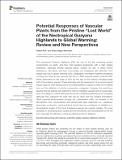Por favor, use este identificador para citar o enlazar a este item:
http://hdl.handle.net/10261/143822COMPARTIR / EXPORTAR:
 SHARE SHARE
 CORE
BASE CORE
BASE
|
|
| Visualizar otros formatos: MARC | Dublin Core | RDF | ORE | MODS | METS | DIDL | DATACITE | |

| Título: | Potential Responses of Vascular Plants from the Pristine “Lost World” of the Neotropical Guayana Highlands to Global Warming: Review and New Perspectives |
Autor: | Rull, Valentí CSIC ORCID ; Vegas-Vilarrúbia, Teresa | Palabras clave: | Acclimation Adaption Extinction Global warming Habitat loss Migration Plant responses |
Fecha de publicación: | 2017 | Editor: | Frontiers Media | Citación: | Frontiers in Plant Science, 8: article number 81 (2017) | Resumen: | The neotropical Guayana Highlands (GH) are one of the few remaining pristine environments on Earth, and they host amazing biodiversity with a high degree endemism, especially among vascular plants. Despite the lack of direct human disturbance, GH plants and their communities are threatened with extinction from habitat loss due to global warming (GW). Geographic information systems simulations involving the entire known vascular GH flora (>2430 species) predict potential GW-driven extinctions on the order of 80% by the end of this century, including nearly half of the endemic species. These estimates and the assessment of an environmental impact value for each species led to the hierarchization of plants by their risk of habitat loss and the definition of priority conservation categories. However, the predictions assume that all species will respond to GW by migrating upward and at equal rates, which is unlikely, so current estimates should be considered preliminary and incomplete (although they represent the best that can be done with the existing information). Other potential environmental forcings (i.e., precipitation shifts, an increase in the atmospheric CO2 concentration) and idiosyncratic plant responses (i.e., resistance, phenotypic acclimation, rapid evolution) should also be considered, so detailed eco-physiological studies of the more threatened species are urgently needed. The main obstacles to developing such studies are the remoteness and inaccessibility of the GH and, especially, the difficulty in obtaining official permits for fieldwork. © 2017, Frontiers Research Foundation. All rights reserved. | Versión del editor: | http://dx.doi.org/10.3389/fpls.2017.00081 | URI: | http://hdl.handle.net/10261/143822 | DOI: | 10.3389/fpls.2017.00081 | ISSN: | 1664-462X |
| Aparece en las colecciones: | (Geo3Bcn) Artículos |
Ficheros en este ítem:
| Fichero | Descripción | Tamaño | Formato | |
|---|---|---|---|---|
| Rull_Frontiers_in_Plant_Science_8_81.pdf | 1,23 MB | Adobe PDF |  Visualizar/Abrir |
CORE Recommender
PubMed Central
Citations
1
checked on 17-abr-2024
SCOPUSTM
Citations
7
checked on 24-abr-2024
WEB OF SCIENCETM
Citations
6
checked on 23-feb-2024
Page view(s)
215
checked on 24-abr-2024
Download(s)
222
checked on 24-abr-2024
Google ScholarTM
Check
Altmetric
Altmetric
Artículos relacionados:
NOTA: Los ítems de Digital.CSIC están protegidos por copyright, con todos los derechos reservados, a menos que se indique lo contrario.
